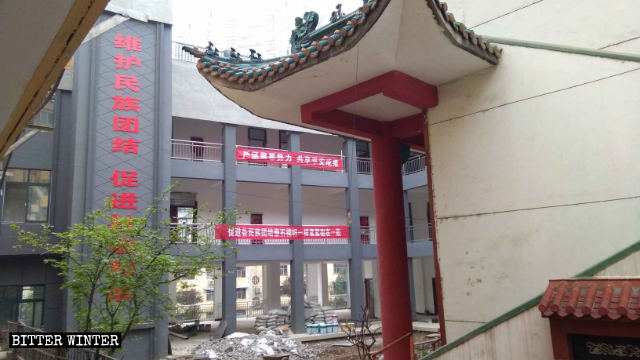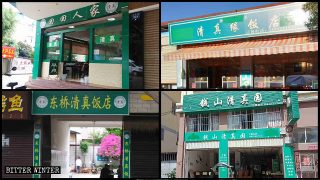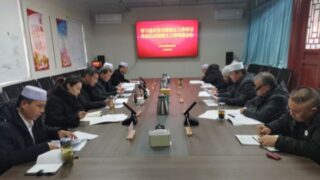The CCP is implementing a systematic plan to eliminate the faith and customs of Hui Muslims, as buildings undergo “facelifts” to rid them of Islam-related symbols.
by Ma Xiagu
The enactment of CCP’s plan to completely “sinicize” Islam outside of Xinjiang within five years is in full force: One after another, the star and crescent symbols and dome-shaped structures are being forcibly dismantled from mosques, replaced with Chinese flags and communist propaganda slogans. As Hui Muslims in the western provinces of Gansu and Shaanxi and Ningxia Hui Autonomous Region see their symbols disappear, their fears of the same fate as Uyghurs in Xinjiang intensify.


In April, a mosque for women on Motianyuan Road in Baoji city in Shannxi was “sinicized”: not only the big blue dome and the star and crescent symbols have been removed from the roof, but the Islamic-style façade, door and window frames have also been changed to reflect a more Chinese style. The “facelifted” mosque looks more like an office building now, and the national flag has been planted on the roof.


According to a construction worker, the renovation project lasted more than one month. The government’s opinion was that the mosque’s Islamic overtones were “too strong,” so they had to be changed.


The mosque on Baoji’s Qunzhong Road used to have eye-catching Islamic symbols. Not anymore: they have been replaced with propaganda slogans, emphasizing “political awareness,” such as “Maintain ethnic unity and promote social harmony,” “‘Four Requirements’ Mosque Activity Proposal,” “Carry out in-depth studies of Regulations on Religious Affairs, and strive to be patriotic, law-abiding, outstanding Muslims.”


In Xi’an, the capital of Shaanxi, the dome and star and crescent symbols were removed from Beiguan Mosque, located in Lianhu district. A member of the mosque told Bitter Winter that the authorities, in an attempt to avoid public exposure of their actions, first put pressure on the imam to intimidate the mosque into removing the Islamic symbols. “Before the dismantling, officials from the Religious Affairs Bureau, community office, Urban Construction Bureau, and district government came five times to ‘work on them,’ and threatened to arrest the imam,” said the man.


Shenjiaping Mosque in Linxia Hui autonomous prefecture in Gansu has also lost its Islamic symbols as part of the “sinicization” campaign.


Ningxia, an autonomous region neighboring Gansu and Shaanxi, is inhabited by about 20 percent of China’s Hui population. Despite this, the de-Muslimization campaign is in full swing, as Islamic symbols are removed from mosques, regular buildings, and tourist attractions.


Ningxia Horticultural Industrial Park, a national AAA-level tourist attraction located in Helan county, under the jurisdiction of Yinchuan city, had all Islamic-style symbols removed or covered from the main entrance as well as the entrances to four exhibition halls. The colored dome and Islamic symbols on the eight corners atop the Popular Science Tower inside the park had all been dismantled.


As the de-Arabization campaign sweeps across western China, many Hui residents are afraid that they will soon face the same plight as Uyghurs in Xinjiang, even though the CCP regarded them as the exemplary Chinese Muslims and patriots until recently. They don’t dare to resist and are forced to conceal their dissatisfaction and fear. “This is a nationwide campaign now. Surveillance cameras are everywhere. Anyone who doesn’t comply will be arrested. If we want to survive, we have no choice but to allow the state to push us around,” a local Hui man said helplessly, describing the precarious situation of Muslims in China.









